Light and darkness. Shadows and highlights. Ornate buildings take on a whole new character at night when the daytime sun no longer illuminates the building. The planners of tonight's concert--one of the fifteen performances in the Summer Music Festival 2005 at the Washington National Cathedral--opted not to illuminate brightly the performance space, but to allow the elaborately carved walls and ceilings of the cathedral to form a dramatic, changing, chiaroscuro backdrop for the sixteen a capella singers of "Phoenix." Light and darkness continued in the music, as well, as the group sang alternating movements of darker contrapuntal music from a 16th century Christopher Tye Mass with contemporary 20th century motets about lux, or "light." In addition, during the first half of the concert, the setting sun continued to shine through the stained glass of the clerestory windows, not only allowing the liturigcal portrayals in the windows to glow and later darken, but also casting beams of colored light through the upper part of the sanctuary. Those beams reminded me of the symbolism of light in gothic style churches that dates all the way back to the construction of the Abbey Church of St. Denis, the very first gothic building in the Middle Ages, and its creators' studies of the philosophy of Pseudo-Dionysius, who taught that symbols such as light and beauty move us towards God.
It was in this mystical space that we heard tonight's concert. What was particularly interesting was the performance location within the vast cathedral. The previous two series concerts I'd attended put the performers in the crossing and the audience in the nave. Tonight, though, the organizers set up hundreds of chairs in the Great Quire, and the singers stood in the sanctuary to perform. Between the permanent stalls for choir and chapter and the supplemental chairs set up in the aisles between the stalls, I estimate that there was seating for 450-500 people (it should tell you how big this place is if you remember this is just the choir or chancel area of the cathedral!). It's a very interesting space, being fairly long and narrow and approximately four stories high. In the area of the stalls, the lower half of the walls are of highly carved walnut and walnut paneling, with artistically arranged organ pipes on each side, and above that white limestone with a heavily ribbed ceiling and stained glass windows on the clerestory level. The sanctuary, of course, is largely of sculpted white marble with limestone and stained glass in the top half. The special intimate acoustics of this area of the cathedral were soon to lend themselves to the delicacy of this all-a capella concert.
Phoenix is a group of young-ish church musicians drawn from across the northeast coast, and it has been performing across the country since 1996, specializing in English choral music. They have an interesting mix of singers, with nine men (one is a counter-tenor) and seven women, plus a conductor. They entered the sanctuary to stand behind black music stands in a large semi-circle, parts mixed, with all the gentlemen in black tuxedos and the women in a variety of styles of conservative long black dresses, and the conductor in a cream dinner jacket. I noticed an interesting thing about the group: they were all brunettes!
The first half of the concert was devoted to Tye's Mass Euge Bone, opening with the 16th century John Taverner's "Kyrie LeRoy" and then between each of the Mass movements, they sang contemporary "lux" motets, namely "O nata lux" by Morten Lauridsen (b. 1943), "Lux Aurumque" by Eric Whitacre (b. 1970), and "Lux AEterna" by Edwin Fissinger (1920-1990). This interplay made for quite an interesting balance of moods. The choir was at its best with the contemporary motets. The pianissimos and diminuendos of "O nata lux" were particularly beautiful. I didn't know the lux motets, so I can't say much about the works or the composers other than the fact that they shared a contemporary British feel in their chordal structures and harmonies, and some of the passages felt very familiar, reminding me of some of the British anthems I've sung by other composers. The Tye Mass presented some interesting challenges for the group. Now, I don't want to give a negative impression of the group, because their mastery of the music and their level of artistry far exceeds what we generally hear from church and collegiate choirs. Music from the 16th century can be very challenging for modern choirs to sing, since that era of music expected a trained singer's voice eventually to "solidify," and to lose any wobble, tremolo, or vibrato; modern operatically-trained singers tend to strive for such vibrato. This group also used female singers, but we should remember than in the 16th century, the high parts were sung either by boys choirs or by castrati, since a papal decree forbade women from singing in public. Music written for castrati will be hard for modern women to sing because not only were soaring high notes put in, but castrati were particularly prized for the richness of their lower registers, and few modern female sopranos will have that kind of range. In the Taverner, the singers were particularly careful to enunciate their consonants, giving us especially explosive K's for repetitions of "kyrie," and that made me hopeful for the rest of the concert. Unfortunately, though, the diction lost crispness in many of the more elaborate sections of the Tye Mass, and that was often quite noticeable in the lower voices during some of the melismas. I also had the feeling that several of the women were working hard to hold their voices back, since some entrances felt shaky and almost cracked. They were doing that, though, to blend in, stop the vibrato, and keep their voices from sticking out, and I must say that overall, the blend of the choir was very pleasing.
For the first half of the concert, we sat on the fifth row back from the altar rail. During the second half, we moved and sat twenty rows further back on the next to the last row of the chairs in the choir, just in front of the rood screen. While the closer seat gave us a better feel of the voices as they entered during the contrapuntal sections and the individual personalities of some of the singers, the seat further back not only gave us a better overall blend, but gave us more of a sense of the cathedral's reverberant "echo". It would have been nice to have had a chance to go out into the nave to hear the sound from out there, as well, but perhaps we can do that for another concert. The second half of the concert was devoted to three of the great British composers of the 20th century. They opened with Charles Villiers Stanford's "Magnificat, anima mea," his long Latin version (not one of his Mag and Nunc settings for Evensongs) that I've never thought was very exciting. Next was a "Chorale after an Old French Carol" by Benjamin Britten which was pretty, but the diction was so blurred I could not swear that they were actually singing the English words in English. Finally, they did Herbert Howell's Requiem, a little known work hidden by the composer until shortly before his death thought to be a response to the death of his son and a preliminary study for Howell's big festival piece, Hymnus Paradisi. The two major portions of the Requiem are settings of Psalms 23 (rather forgettable) and 121 (very nice), with two variations on "requiem aeternam" in between, and all flanked by a "Salvador mundi" up front and "I heard a voice from heaven" at the conclusion The baritone (who looked a lot like the British actor Rupert Graves) and tenor soloists had opportunities to shine in Psalm 121. The first "requiem aeternam" variation had a lot of nice pedal tones from the basses, and the second variation had some of the very few soaring, "big" moments in the evening's performance.
Tuesday, July 26, 2005
Friday, July 22, 2005
Size matters
Last night's National Symphony Orchestra concert answers positively the age-old question as to whether or not organ size matters. In this case, the organ is the four-manual, 186-rank, Aeolian-Skinner pipe organ at the Washington National Cathedral, which was the star performer in the NSO's entry in the cathedral's Summer Music Festival 2005, and it answers the question with a resounding yes. Many of you have played in an orchestra or been in sufficiently close proximity to one to know just how loud an orchestra can get. Couple that experience with the knowledge that the NSO is a particularly large orchestra and it was playing in the very live and very reverberent marble and limestone cavern that is the National Cathedral, and then know that no matter how loudly the orchestra played, the cathedral organ could out-blast and out-soar the orchestra at its most thrilling fortissimos.
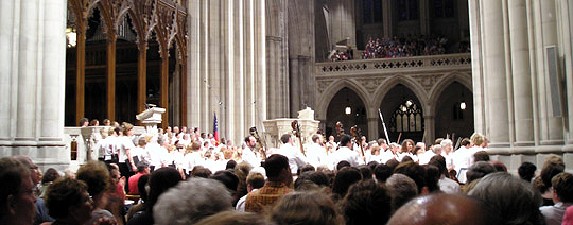
The highlight of the evening was Francis Poulenc's Concerto in G minor for Organ, Strings, and Timpani, featuring J. Reilly Lewis adeptly at the cathedral organ. Poulenc's concerto, written in 1938, is a study in diminished chords, driven home ever so forcefully with the organ's ability to sustain the sound. This has long been one of my favorite organ works, and I used to drive the interstate highways of the American Southwest with a recording blasting from my car stereo. I've heard the concerto live twice, once in an auditorium with a "temporary" electronic organ and once in a church with an anemic-sounding 33-rank organ. None of that prepared me for last night.
As you can see in the ("illegally" taken) picture above, I was seated in the middle of the north transcept for this performance. It's not an area I would normally choose for a concert, but it's my friend's favorite place to sit in the cathedral for church and that preference defaults to concerts as well. Since I was fifteen minutes late for our agreed meeting time (see earlier post with my rant about Metro buses!), they went ahead and picked our seats without my input. It turned out to be a fortuitous choice. The majority of the organ pipes are in the Great Choir, which you can see to the left, behind the rood screen, with the sound pouring out from there. The orchestra's sound came from the center and from the right. This combination gave me an antiphonal effect I've never had before from listening to recordings or sitting in front of an orchestra with organ speakers over head. What an experience!
The first half of the concert was devoted to Charles Gounod's Messe Solennelle de Sainte Cécile with the Cathedral Choral Society Summer Chorus joined by the Fairfax (Virginia) Choral Society. The soloists were Jessica Swink, soprano, Tim Augustin, tenor, and Jon Bruno, bass, and CCS's music director, J. Reilly Lewis, conducted. Unfortunately I was not able to see the conductor or the soloists from my vantage point, and only noticed during curtain calls that the soprano had long auburn hair and wore a rich beige, satin dress, one of the men was in a black tuxedo and the other was in a dark suit. The entire crossing of the cathdral was filled with musicians, with the orchestra on the floor level and the singers filling the chancel steps and supplemental risers to the sides of the lecturn and the pulpit. I was disappointed by their decision to mike the soloists and chorus. As was so aptly demonstrated last Sunday at the Thomas Tallis Quincentenary Concert, no amplification is needed in the cathedral space. The high treble balance of the speakers was particularly disconcerting, and, in fact, at one point where the tenor soloist came in, the treble was so prevalent that I did a double take to see if there was an alto somewhere!
Because of my seating location, I was right by the "live" sound of the chorus, and occasionally had to wrestle with the several millisecond delay of the amplified sound and the few second delay of the cathedral reverberation (there is about a four to six second sound decay time in the cathedral). Even cutting through the acoustical issues, though, the chorus struggled a couple of times during some of the faster sections of the Gloria (I had to slap my hand at one point when I spontaneously conducted a couple of beats in my lap, trying to help the chorus stay together!). The Credo was a bit muddy at times, but otherwise, the rest of the choral portions were fine. I liked the bass soloist's voice, and it's unfortunate that Gounod didn't write more for him to sing. The soprano was ok, though I thought her voice had more of the character of a mezzo-soprano than a full-fledged soprano. The tenor didn't impress me much. I thought his voice lacked maturity and richness (which may have been the fault of the miking), and he covered his top notes too early.
The most interesting thing about the entire Mass for me, though, was the inclusion of the eighth movement of the Mass, Domine Salvam, which is something I'd vaguely read about but never before heard and certainly never sung. This final movement follows the Agnus Dei and is a rather patriotic setting of the text "God save our Republic! And hear us in that day when we shall call upon thee." It's a politically interesting inclusion, since the Mass was written about six or seven years after the second French Revolution of 1848.
The second half of the concert, which opened with the Poulenc, was conducted by NSO's associate conductor, Emil de Cou. At times, I think I like de Cou's work better than music director Leonard Slatkin's, since the NSO always sounds warm with de Cou and I've often felt the orchestra sounded either under-rehearsed or soul-less when I've heard Slatkin conducting. After the Poulenc, they played Maurice Ravel's "Pavane pour une infante défunte," or as it is more popularly known, "Pavane for a Dead Princess," or, as I prefer to translate the French, "Dance for a Dead Baby." I was a little bored with the idea of the Pavane, since this is one of those "top forty" classical songs one hears incessantly on the national classical music radio feeds. NSO's interpretation was pretty enough, but what made the moment magical—and something which can only happen in a live performance—was that, as the orchestra was making its final ritardando and diminuendo, a baby in the back gave a bit of a cry.
The final selection was another "top forty" war horse, Benjamin Britten's The Young Person's Guide to the Orchestra. I was tempted to leave early along with many other members of the audience (especially since the festival director was making announcements before the piece started), but I'm glad I stayed. They took liberties with the music. In fact, they rearranged the score to include a part for pipe organ! It was magnificent. This piece is really a set of variations on a theme by Purcell, and the theme is introduced in this big, pompous, ponderous way, bolstered in this case with the mighty sound of the cathedral organ. Throughout the rest of the piece, the organ occasionally wove its way unobtrusively through the music, only to return triumphantly with the final chords of the finale. The windows rattled. Wow. Britten will never be the same again.
If you look again at the picture above, you'll see the orchestra and chorus facing to the right towards the conductor and the nave. Did you notice that the double basses have their backs to us? I thought that was interesting, since the basses usually sit on the opposite side of the stage. The performers were also dressed in an interesting "summer uniform." The men of the orchestra were wearing starkly white dinner jackets (my summer dinner jacket is cream, a color I've always preferred), which I thought an interesting choice, given the white marble and white limestone surroundings of the performance space. If you've never been in the cathedral, you can't see it from the picture, but the bulk of the audience sitting in the nave looks through the rood screen, directly at the high altar, which is an enormous bit of carved white marble. So, there wasn't much contrast between the costumes and the backdrops. Of course, I was particularly appalled by the costuming decisions for the chorus men, who wore white shirts (some even inshort sleeved shirts! :::gasp!:::) with black bow ties and no jackets. One might have thought it was a caterer's convention with hundreds of waiters let loose and having abandoned their aprons. There was a standing room only crowd in the cathedral for the concert, and people were sitting every where. They accomodated people sitting in the aisles (think formal cathedral definition of "aisle"), side chapels, and niches with big screen plasma TV monitors on every two pillars out in the nave. giving them a closer view of the conductor's back. Didn't see many people I knew, but H.E. the Norwegian Ambassador to the United States was seen in the audience.
The cathedral's music festival continues on for the rest of the month, with a concert of the words of Albert Schweitzer and the music of J. S. Bach tonight.

The highlight of the evening was Francis Poulenc's Concerto in G minor for Organ, Strings, and Timpani, featuring J. Reilly Lewis adeptly at the cathedral organ. Poulenc's concerto, written in 1938, is a study in diminished chords, driven home ever so forcefully with the organ's ability to sustain the sound. This has long been one of my favorite organ works, and I used to drive the interstate highways of the American Southwest with a recording blasting from my car stereo. I've heard the concerto live twice, once in an auditorium with a "temporary" electronic organ and once in a church with an anemic-sounding 33-rank organ. None of that prepared me for last night.
As you can see in the ("illegally" taken) picture above, I was seated in the middle of the north transcept for this performance. It's not an area I would normally choose for a concert, but it's my friend's favorite place to sit in the cathedral for church and that preference defaults to concerts as well. Since I was fifteen minutes late for our agreed meeting time (see earlier post with my rant about Metro buses!), they went ahead and picked our seats without my input. It turned out to be a fortuitous choice. The majority of the organ pipes are in the Great Choir, which you can see to the left, behind the rood screen, with the sound pouring out from there. The orchestra's sound came from the center and from the right. This combination gave me an antiphonal effect I've never had before from listening to recordings or sitting in front of an orchestra with organ speakers over head. What an experience!
The first half of the concert was devoted to Charles Gounod's Messe Solennelle de Sainte Cécile with the Cathedral Choral Society Summer Chorus joined by the Fairfax (Virginia) Choral Society. The soloists were Jessica Swink, soprano, Tim Augustin, tenor, and Jon Bruno, bass, and CCS's music director, J. Reilly Lewis, conducted. Unfortunately I was not able to see the conductor or the soloists from my vantage point, and only noticed during curtain calls that the soprano had long auburn hair and wore a rich beige, satin dress, one of the men was in a black tuxedo and the other was in a dark suit. The entire crossing of the cathdral was filled with musicians, with the orchestra on the floor level and the singers filling the chancel steps and supplemental risers to the sides of the lecturn and the pulpit. I was disappointed by their decision to mike the soloists and chorus. As was so aptly demonstrated last Sunday at the Thomas Tallis Quincentenary Concert, no amplification is needed in the cathedral space. The high treble balance of the speakers was particularly disconcerting, and, in fact, at one point where the tenor soloist came in, the treble was so prevalent that I did a double take to see if there was an alto somewhere!
Because of my seating location, I was right by the "live" sound of the chorus, and occasionally had to wrestle with the several millisecond delay of the amplified sound and the few second delay of the cathedral reverberation (there is about a four to six second sound decay time in the cathedral). Even cutting through the acoustical issues, though, the chorus struggled a couple of times during some of the faster sections of the Gloria (I had to slap my hand at one point when I spontaneously conducted a couple of beats in my lap, trying to help the chorus stay together!). The Credo was a bit muddy at times, but otherwise, the rest of the choral portions were fine. I liked the bass soloist's voice, and it's unfortunate that Gounod didn't write more for him to sing. The soprano was ok, though I thought her voice had more of the character of a mezzo-soprano than a full-fledged soprano. The tenor didn't impress me much. I thought his voice lacked maturity and richness (which may have been the fault of the miking), and he covered his top notes too early.
The most interesting thing about the entire Mass for me, though, was the inclusion of the eighth movement of the Mass, Domine Salvam, which is something I'd vaguely read about but never before heard and certainly never sung. This final movement follows the Agnus Dei and is a rather patriotic setting of the text "God save our Republic! And hear us in that day when we shall call upon thee." It's a politically interesting inclusion, since the Mass was written about six or seven years after the second French Revolution of 1848.
The second half of the concert, which opened with the Poulenc, was conducted by NSO's associate conductor, Emil de Cou. At times, I think I like de Cou's work better than music director Leonard Slatkin's, since the NSO always sounds warm with de Cou and I've often felt the orchestra sounded either under-rehearsed or soul-less when I've heard Slatkin conducting. After the Poulenc, they played Maurice Ravel's "Pavane pour une infante défunte," or as it is more popularly known, "Pavane for a Dead Princess," or, as I prefer to translate the French, "Dance for a Dead Baby." I was a little bored with the idea of the Pavane, since this is one of those "top forty" classical songs one hears incessantly on the national classical music radio feeds. NSO's interpretation was pretty enough, but what made the moment magical—and something which can only happen in a live performance—was that, as the orchestra was making its final ritardando and diminuendo, a baby in the back gave a bit of a cry.
The final selection was another "top forty" war horse, Benjamin Britten's The Young Person's Guide to the Orchestra. I was tempted to leave early along with many other members of the audience (especially since the festival director was making announcements before the piece started), but I'm glad I stayed. They took liberties with the music. In fact, they rearranged the score to include a part for pipe organ! It was magnificent. This piece is really a set of variations on a theme by Purcell, and the theme is introduced in this big, pompous, ponderous way, bolstered in this case with the mighty sound of the cathedral organ. Throughout the rest of the piece, the organ occasionally wove its way unobtrusively through the music, only to return triumphantly with the final chords of the finale. The windows rattled. Wow. Britten will never be the same again.
If you look again at the picture above, you'll see the orchestra and chorus facing to the right towards the conductor and the nave. Did you notice that the double basses have their backs to us? I thought that was interesting, since the basses usually sit on the opposite side of the stage. The performers were also dressed in an interesting "summer uniform." The men of the orchestra were wearing starkly white dinner jackets (my summer dinner jacket is cream, a color I've always preferred), which I thought an interesting choice, given the white marble and white limestone surroundings of the performance space. If you've never been in the cathedral, you can't see it from the picture, but the bulk of the audience sitting in the nave looks through the rood screen, directly at the high altar, which is an enormous bit of carved white marble. So, there wasn't much contrast between the costumes and the backdrops. Of course, I was particularly appalled by the costuming decisions for the chorus men, who wore white shirts (some even inshort sleeved shirts! :::gasp!:::) with black bow ties and no jackets. One might have thought it was a caterer's convention with hundreds of waiters let loose and having abandoned their aprons. There was a standing room only crowd in the cathedral for the concert, and people were sitting every where. They accomodated people sitting in the aisles (think formal cathedral definition of "aisle"), side chapels, and niches with big screen plasma TV monitors on every two pillars out in the nave. giving them a closer view of the conductor's back. Didn't see many people I knew, but H.E. the Norwegian Ambassador to the United States was seen in the audience.
The cathedral's music festival continues on for the rest of the month, with a concert of the words of Albert Schweitzer and the music of J. S. Bach tonight.
Revoicing
The piano company retained by the movers called. They are coming Monday morning to pick up my piano. In addition to the leg repairs, they'll be revoicing it and raising the pitch.
I did some serious vocalization in the evening for the first time in months. Got my G back, but the A-flat still isn't fit for public consumption.
I did some serious vocalization in the evening for the first time in months. Got my G back, but the A-flat still isn't fit for public consumption.
Thursday, July 21, 2005
Closed captioning
Early this morning I was watching The Pretender on TNT, and the closed captioning just happened to be on. At the end of the show as it segued into "next week's adventure," there was Jarrod astride his faithful steed, resplendent in a bright red Mounties uniform, as "O, Canada!" swelled inspirationally in the background.
The caption gave the little music symbol and identified the music as "William Tell Overture" (think Lone Ranger theme song).
I didn't know Rossini was Canadian!
What are the ironies in a closed captioning service for the deaf not being able to hear the difference between "O, Canada" and the "William Tell Overture"? In fact, I've never really understood why the captioners attempt to identify the music. If it's a modern pop song, they'll indicate the lyrics, and I'm ok with that, but when the music is instrumental, do deaf people really care? Gallaudet University is here in D.C......I suppose I could track down a student and ask him or her if it matters if a sound track is "William Tell Overture" or Handel's Water Music. Can any of you enlighten me?
Meanwhile, my great dilemma for the day is whether or not to try to track down the captioning organization and point out their error!
The caption gave the little music symbol and identified the music as "William Tell Overture" (think Lone Ranger theme song).
I didn't know Rossini was Canadian!
What are the ironies in a closed captioning service for the deaf not being able to hear the difference between "O, Canada" and the "William Tell Overture"? In fact, I've never really understood why the captioners attempt to identify the music. If it's a modern pop song, they'll indicate the lyrics, and I'm ok with that, but when the music is instrumental, do deaf people really care? Gallaudet University is here in D.C......I suppose I could track down a student and ask him or her if it matters if a sound track is "William Tell Overture" or Handel's Water Music. Can any of you enlighten me?
Meanwhile, my great dilemma for the day is whether or not to try to track down the captioning organization and point out their error!
Sunday, July 17, 2005
Tallis quincentenary
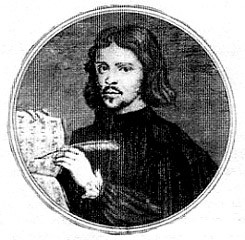
Just got back from a concert at the National Cathedral celebrating the quincentenary of the birth of the English composer Thomas Tallis. Most of you would probably recognize a hymn tune of his which is often sung as a round, usually with the words "All praise to thee my God this night, for all the blessing of the light: keep me, o keep me, King of kings, beneath thine own almighty wings." Long time church choristers may also remember singing an English motet called "If ye love me, keep my commandments." Anyway, tonight's concert was devoted exclusively to Tallis's a capella choral compositions, sung by five different area choral ensembles. This concert is a part of the month-long Summer Music Festival at the cathedral, wherein several free concerts are given each week from a broad range of performers and genres. I got there tonight about fifteen minutes early, and had to sit at the back of the front half of the nave. Eventually, the north and south transepts were also filled, and I'd say about a third of the back half of the nave was full. The audience was quite diverse and seemed to have people from all age groups. The past several days, there has been a Tallis workshop going on at the cathedral with musicians from all over, led by Philip Cave, an original singer with the Tallis Scholars choral ensemble and the director and founder of the English choral group Magnificat.
The program opened with "Loquebantur varlis linguis" (the apostles did speak with many tongues), sung by the Choir of Men and Girls of the Washington National Cathedral. The choir was surprisingly small, with about five men and six high school aged girls. I guess most of the girls are off on summer vacation, since the choir for services is much larger. The next ensemble was the Choir of St. Paul's Episcopal Church, Rock Creek, that sang "Te lucis ante terminum" (before the ending of the day), "Salvator mundi" (Savior of the world), and "In ieiunion et fletu" (fasting and weeping). This was another small group, and there was one guy in the group who was absolutely adorable, even from way back where I was sitting!
The only English-language anthems were sung by the Woodley Ensemble, which did "If ye love me," "Hear the voice and prayer," and "O Lord, give thy Holy Spirit." This was a little bit bigger group. One of the men had this very unfortunate tendency to bob and sway wildly as he sang, though, and all that movement made his hair comb-over fall out of place and become very obvious. The "large" group of the day was the Palestrina Choir, which sang "In manus tuas" (Into your hands), "Candidi facti sunt" (Made radiantly white), and "O nata lux de lumine" (O light of light). They were certainly the most polished group of the evening. I noticed there were several people who sang in multiple ensembles, especially with this one. The last group to sing was the Schola Cantorum from St. Matthew's (Catholic) Cathedral. Another small group, they did "O sacrum convivium" (O sacred banquet) and "O salutaris hostia" (O saving victim), a couple of pieces they recently recorded for their CD. They use microphones at St. Matt's, so they weren't quite used to the live acoustic here.
A couple of notes seem common to all of the ensembles. The acoustics of the cathedral are amazing. Even the small groups of eight singers could be clearly heard without any amplification. That acoustic was rather unforgiving in some of the less-well-rehearsed passages, where the diction got a little muddy. I was also reminded, unfortunately, with each ensemble, why the early, medieval, and Renaissance church used choirs of men and boys instead of choirs with adult women. It is extremely hard for women to sing with a "straight tone" and avoid using their vibrato to help keep the pitch on target, even with these auditioned, professional singers. At some point, each group had some major pitch problems when the women went flat. Now, I certainly don't want to infer that boys never go flat, but they naturally sing in straight tone, so I find that most trained boys choirs do a much better job with pitch and intonation on this type of music.
For the finale, all of the groups came on stage to sing Tallis's masterpiece, the motet "Spem in alium", conducted by workshop leader Philip Cave. Now, most choral music is arranged for four parts (for example, soprano, alto, tenor, and bass), and some complex music today may be written for eight parts or for a "double choir". This motet, though, is written for forty parts, distributed amongst octuple choirs! Because of it's difficulty, it isn't often performed. This is the first time I have ever heard a live performance of the piece. About twenty years ago, I sang the motet with the Canterbury Choral Society, but you get a completely different perspective of the work when you are in the ensemble and are trying to concentrate on one part and watch the conductor. Our performance was also complicated a bit by the director's decision to spread the choir out all over the Civic Center Music Hall (before the big remodeling process in Oklahoma City's post-bombing renewal), rather than keep the group together on stage. Today was, then, a really exciting opportunity for me to hear this piece (and the main reason I went to the otherwise rather dry concert). They acquitted themselves well. There were, as expected, a couple of places where the parts get dense when some of the voices got lost, but they eventually picked it back up again. The subito fortes were of wonderous effect in the cathedral acoustic. It made a fine ending for the hour-long concert.
I was rather amused during the concert by an elderly man sitting in front of me a bit. He came in before the concert began to find his seat, then he pulled out this big book called Einstein in Berlin, and he proceded to read it during the entire concert! He looked rather annoyed during those moments of applause, which, I guess, distracted him from his reading. After the final ovation, he closed his book up and left with the rest of the audience. I have no idea why he came to the concert, if he was just going to read!
Bond and Batik with Baj
Last week, my friend Baj was headed back to Toronto, so before he left, we got together to see a bit more of esoteric Washington. Baj was very interested in going to the Textile Museum to see their temporary exhibit of Southeastern Asian textiles, so we went over there. The textiles were from very southeastern Asia, like Indonesia, Borneo, New Guinea, and so forth. I found it very interesting how in many of these cultures, they wove magical designs into their cloth and there were special designs and even colors which were reserved to the royalty. Some of the designs are incredibly ornate and filled with rich colors.
After the Textile Museum, we headed over to the International Spy Museum in the Gallery Place area. The Spy Museum has to be one of the most interesting museums in D.C. If any of you comes to D.C. to play tourist, put this place at the top of your list, even before the stereotypical Smithsonian places. They have a temporary exhibit right now on domestic terrorism that started way back with assassination attempts on General Washington during the Revolution, and come forward to the present day, that was narrated with a portable headset. Then, in the main museum, most exhibits were motion-activated and showed all kinds of spying equipment and devices. Did you know that espionage goes back to biblical times and is mentioned in the Bible? The World War II and Cold War eras produced some particularly interesting and creative "toys." They also had several of the cars and special equipment from the earlier James Bond movies. Some of the fun stuff included the history of cryptography going back as far as Alexander the Great. Marie Antoinette and Thomas Jefferson had special cypher of their own, too. Anyway, even though the Spy Museum is private and one of the few places in D.C. that charge admission, it's well worth the visit. Be careful, though to avoid times when the museum is full of children. They sell tickets at specific times, and it can be packed, especially on weekends.
After the Textile Museum, we headed over to the International Spy Museum in the Gallery Place area. The Spy Museum has to be one of the most interesting museums in D.C. If any of you comes to D.C. to play tourist, put this place at the top of your list, even before the stereotypical Smithsonian places. They have a temporary exhibit right now on domestic terrorism that started way back with assassination attempts on General Washington during the Revolution, and come forward to the present day, that was narrated with a portable headset. Then, in the main museum, most exhibits were motion-activated and showed all kinds of spying equipment and devices. Did you know that espionage goes back to biblical times and is mentioned in the Bible? The World War II and Cold War eras produced some particularly interesting and creative "toys." They also had several of the cars and special equipment from the earlier James Bond movies. Some of the fun stuff included the history of cryptography going back as far as Alexander the Great. Marie Antoinette and Thomas Jefferson had special cypher of their own, too. Anyway, even though the Spy Museum is private and one of the few places in D.C. that charge admission, it's well worth the visit. Be careful, though to avoid times when the museum is full of children. They sell tickets at specific times, and it can be packed, especially on weekends.
Bastille Day
Once again it's time to celebrate the French independence day. Or, at least it was last Thursday.
One of my friends and I made a late afternoon appearance at the Hirschhorn Museum (the "modern art" place at the Smithsonian) to see the Visual Music exhibit. The exhibit wasn't at all what I was expecting, though that isn't necessarily a bad thing. It was just different. There were a few paintings where the artist painted what he "saw" from listing to a work of music. Most of the art was odd film or visually created projections. Part of the charm of the exhibit was that it wasn't recent art, but earlier 20th century works. We also looked at the permanent collection, and I saw this one multimedia sculpture that reminded me a lot of my friend Tony back in Tulsa. No more wire hangers?
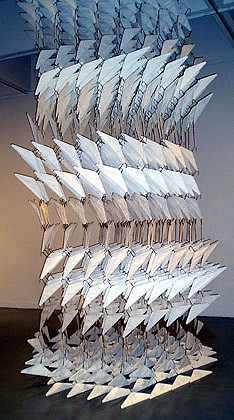
Then, we were in another room and saw some particularly bizarre modern art, and then I looked up on the back wall and saw how they were keeping us from escaping the world of modernism.

One of my friends and I made a late afternoon appearance at the Hirschhorn Museum (the "modern art" place at the Smithsonian) to see the Visual Music exhibit. The exhibit wasn't at all what I was expecting, though that isn't necessarily a bad thing. It was just different. There were a few paintings where the artist painted what he "saw" from listing to a work of music. Most of the art was odd film or visually created projections. Part of the charm of the exhibit was that it wasn't recent art, but earlier 20th century works. We also looked at the permanent collection, and I saw this one multimedia sculpture that reminded me a lot of my friend Tony back in Tulsa. No more wire hangers?

Then, we were in another room and saw some particularly bizarre modern art, and then I looked up on the back wall and saw how they were keeping us from escaping the world of modernism.

Sunday, July 10, 2005
Payday
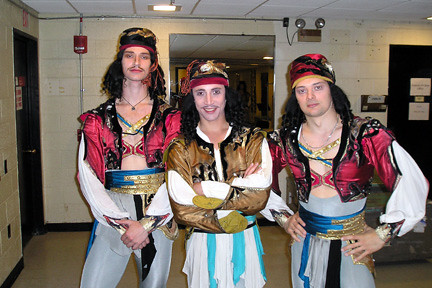
This afternoon was the closing show for Le Corsaire. In the picture above, on the left is the dancer who's actually taller than me. Isn't he just gorgeous?
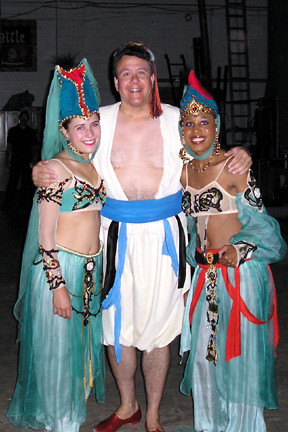
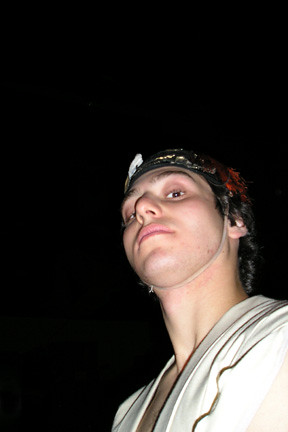
Here I am with a couple of the slave girl supers, Jacquelyn and Stephanie. On the right is Adam, a sailor, who's off to Harvard in the fall.
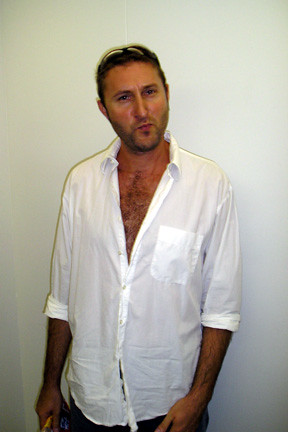
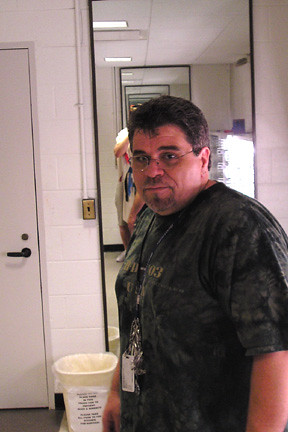
This is Sasha, our makeup artist, and Robbie, our dresser.
After the first act, they actually paid us in cash instead of giving us checks. That kind of surprised me. The fifties and other blls are in this cute little manilla envelope which appears to be the size designed to accommodate a 3x5 index card, a size I've never seen before. The balletmaster invited several of us to come back this winter when the Kirov is back in D.C. again for another show. Could be fun. I enjoyed working with this company.
My foot is still swollen. It's odd....during the shows, I've completely forgotten about the pain, and one of my friends said I wasn't limping or anything. Then today, I noticed as we moved the dance stage the final time that I limped a little bit on my way back to my barrel seat. Hmm.
Back to the routine on the morrow. I shall miss being on stage.
Saturday, July 9, 2005
Two a Days
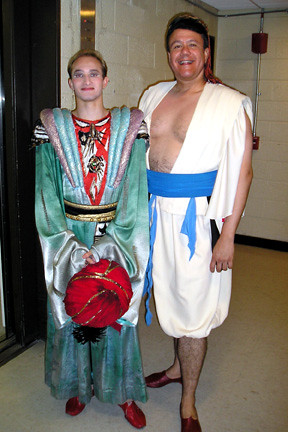
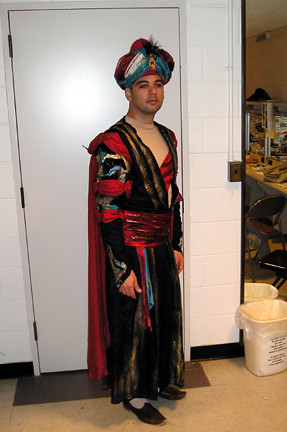
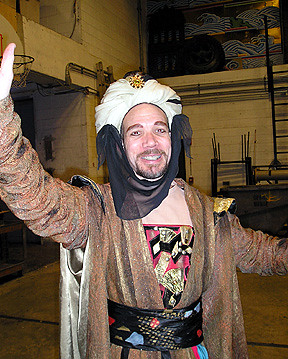
Ah, another day, another two paychecks.....we did two performances today, a matinee and an evening show, and surprisingly enough my foot is still attached. Did any of you ever do two-a-days in football practice in high school? The principal dancers, of course, rotate and don't have to dance twice in the same day, but all of the corps and supernumeraries do every show.
The crowd tonight was particularly enthusiastic and it looked very nearly full. This afternoon, I stayed to watch the second and third acts from the house, and got a lovely box seat from which to do it. All I had to do was waive my backstage pass around the ushers and they directed me to an unused seat. The sets were surprisingly elaborate. The second act is set in a cave, but actually a complex cave with lots of detail and many surfaces. The third act takes place in a harem in a very ornate setting and there are three large water fountains that bubble up high during portions of the act. One of the funny things that happened this afternoon in the first act was one of the lead dancers had "painted" his beard, moustache, sideburns, etc., on with eyebrow pencil, and he managed to get a huge black smudge on the prima ballerina's white tights just above her right knee on the outside, and I couldn't keep my eyes off the black spot for the rest of the act!
Tomorrow afternoon is the last show. I hear the Russians are flying straight out to London after the show. They're booked for a run at Covent Garden.
Thursday, July 7, 2005
This morning's Washington Post
The review of the dress rehearsal for the Kirov Ballet's Le Corsaire is in this morning's Washington Post.
This is the photo that accompanies the review. If you look closely under the ballerina's arm, you can see me in my cream costume with blue sash sitting on my barrel! For those of you who've known me for a while, no, I haven't grown my hair out again, there's a long tassel on my hat. The guy standing in the background on the far right of the photo is the dancer who's taller than me.
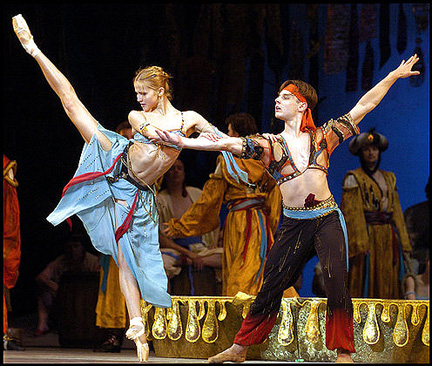
Photo by Katherine Frey. Copyright © 2005 The Washington Post Company. All rights reserved.
To read the review, go to the Washington Post website by clicking here. The Post doesn't keep stuff up long, so if you want to read it at leisure, you might want to go there now and print it out.
This is the photo that accompanies the review. If you look closely under the ballerina's arm, you can see me in my cream costume with blue sash sitting on my barrel! For those of you who've known me for a while, no, I haven't grown my hair out again, there's a long tassel on my hat. The guy standing in the background on the far right of the photo is the dancer who's taller than me.

Photo by Katherine Frey. Copyright © 2005 The Washington Post Company. All rights reserved.
To read the review, go to the Washington Post website by clicking here. The Post doesn't keep stuff up long, so if you want to read it at leisure, you might want to go there now and print it out.
Wednesday, July 6, 2005
Deuxième
Zdravstvujte! Tonight's performance of Le Corsaire went well, and we played to an equally appreciative crowd as last night. I'd estimate, though, that the house was only about 90% full tonight, as I saw some empty seats in the far corners. Interestingly enough, it seems like the cheap seats sell out before the better seats, but that's probably because of the usuriously high ticket prices the Kennedy Center always charges for things (for this show, it's $47 for the third balcony versus $112 for the good seats). And, OMG, before our call tonight, one of the tall, slender blond dancers was striding through my dressing room on his way back from the showers with only a small white towel wrapped around him, and let's just say that the little white towel wasn't long enough.....
Time to go elevate and ice my foot.
Time to go elevate and ice my foot.
Tuesday, July 5, 2005
Le Corsaire prima
Tonight was the opening night for the Kirov Ballet's production of the pirate swashbuckling ballet, Le Corsaire, playing to a happy, responsive, packed house in the Opera House at the Kennedy Center here in Washington. I'm still bouncing around like an ecstatic manic from getting to dance in the first act. The four of us local "sailors" were practically flying by the seat of our pants, since we were just cast and only briefly rehearsed today, and none of us have done this show before or know the music. The ballet master (talk about hot daddy type!) stood in the wings, though, and shouted instructions to us in Russian, and fortunately, we knew enough of our staging to have some semblance of an idea what he was telling us, and I think we got all of our cues. He looked happy. Spasibo!
Ballets are so different from operas. I was actually sewn into my costume, rather than depending on all the suspenders and snaps and safety pins we have for our opera costumes. In opera, I usually get wigged with these multi-thousand dollar natural hair wigs, but the dancers tonight were wearing wigs of crepe hair! Also, we were encouraged to use really broad, overly dramatic gestures to convey our feelings during the act. I felt a little hammy, but it was kinda fun getting to overact for a change! It was really strange, too, being able to see the people in the seats out in the audience, from the people with their opera glasses in the third level balcony to the formally attired patrons in the box tier to the balletomanes in the orchestra section. And, it occurs to me just now that I can't remember whether I was listening to the orchestra from the monitors in the wings or to the live sound echoing from the house. I was never able to see the conductor, and there were no TV monitors showing him, so it never really occurred to me to notice, at least till now. With the opera, we stay focused on the conductor's stick.
And, phermones, oh, my! Dancers sweat more than opera singers, and the dressing rooms were redolent with Russki phermones! And, I am staged during the principals' pas de deux and solos on top of a barrel up right, and as the premier danseur did his leaps and jumps and spins around the stage, every time he was spinning around in my vicinity, I was showered with a spray of his perspiration.
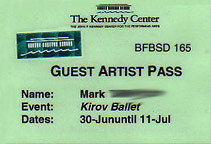
We got these nifty guest artist back stage passes that we have to use to get in the stage door. I have to think about what I might want to buy from the Kennedy Center Gift Shop, cause I get a 15% discount while my pass is still active, and, if I were driving my car, I'd get a huge discount on parking so it only costs $9 per night. Aren't I spayshul?
Who knows how to speak Russian? I've got to figure out how to communicate with these cute Russian dancer boys. We share a restroom/shower room with the male corps de ballet, and there was a constant parade of boys prancing around to and fro in nothing but dance belts. There's one positively adorable guy who's actually taller than me who keeps flirting with me on stage. There are a couple more who blush when I say hello to them. I only live three blocks from the Kennedy Center, and I've been stocking up on Russian vodkas...... Meanwhile, Leo keeps bringing me Cape Cods with Smirnoff's Triple-Distilled Premium Vodka. We're getting happy.
Now, I just have to get out my ice bag so I can ice and elevate my foot to survive the night and then dance again tomorrow. I'm getting too old for this stuff!
Ballets are so different from operas. I was actually sewn into my costume, rather than depending on all the suspenders and snaps and safety pins we have for our opera costumes. In opera, I usually get wigged with these multi-thousand dollar natural hair wigs, but the dancers tonight were wearing wigs of crepe hair! Also, we were encouraged to use really broad, overly dramatic gestures to convey our feelings during the act. I felt a little hammy, but it was kinda fun getting to overact for a change! It was really strange, too, being able to see the people in the seats out in the audience, from the people with their opera glasses in the third level balcony to the formally attired patrons in the box tier to the balletomanes in the orchestra section. And, it occurs to me just now that I can't remember whether I was listening to the orchestra from the monitors in the wings or to the live sound echoing from the house. I was never able to see the conductor, and there were no TV monitors showing him, so it never really occurred to me to notice, at least till now. With the opera, we stay focused on the conductor's stick.
And, phermones, oh, my! Dancers sweat more than opera singers, and the dressing rooms were redolent with Russki phermones! And, I am staged during the principals' pas de deux and solos on top of a barrel up right, and as the premier danseur did his leaps and jumps and spins around the stage, every time he was spinning around in my vicinity, I was showered with a spray of his perspiration.

We got these nifty guest artist back stage passes that we have to use to get in the stage door. I have to think about what I might want to buy from the Kennedy Center Gift Shop, cause I get a 15% discount while my pass is still active, and, if I were driving my car, I'd get a huge discount on parking so it only costs $9 per night. Aren't I spayshul?
Who knows how to speak Russian? I've got to figure out how to communicate with these cute Russian dancer boys. We share a restroom/shower room with the male corps de ballet, and there was a constant parade of boys prancing around to and fro in nothing but dance belts. There's one positively adorable guy who's actually taller than me who keeps flirting with me on stage. There are a couple more who blush when I say hello to them. I only live three blocks from the Kennedy Center, and I've been stocking up on Russian vodkas...... Meanwhile, Leo keeps bringing me Cape Cods with Smirnoff's Triple-Distilled Premium Vodka. We're getting happy.
Now, I just have to get out my ice bag so I can ice and elevate my foot to survive the night and then dance again tomorrow. I'm getting too old for this stuff!
Première
Tonight is my performance premiere both in Washington and at the Kennedy Center, and I'm very excited to have been cast as one of the four sailors in the Marinski Theater Kirov Ballet production of Le Corsaire. I'm home now for a quick break and my feet are killing me! We have dress rehearsal at 3, and then the production opens tonight at 7:30 and runs every night through Saturday, plus a Saturday and Sunday matinee.
We're dancing in the Opera House, and it is a thrill to be in there. The stage itself is almost as big as the stage in the Chapman Music Hall in Tulsa, but it is much taller, and the backstage areas are huge, with probably the same size area as the main stage to the left, right, and rear. Dressing and rehearsal rooms are on four levels, and it's so confusing trying to remember what is on what floor. It's also a little scary looking out into the house where there is not only a large orchestra section, but three balcony levels, and the seats are surprisingly visible from the stage (usually when I'm singing, all I can see out in the house is a big black hole and maybe a few rows at the very bottom of the orchestra section). I hope I don't miss any calls. The backstage announcements are all being made in Russian! Our casting session and first rehearsal were also done in Russian with a Russian lady translating the ballet master's comments into English for us.
My costume is a little scanty. We're in cream raw silk blousey knee breeches with a matching vest and a bright blue sash with red leather pointy-toed shoes and a pill-box type hat with a big silk tassel on the side. The vests are designed to show off our big, muscular chests. LOL
The Russian dancers are spectacular. The company is quite large, and I was rather surprised to notice a lot of tall, handsome, Russian male dancers--most of the dancers I know in the U.S. tend to be rather short and slender. I was watching the company class (a/k/a warm-ups) this morning, and several of those dancers are positively breathtaking with legs and butts to die for! And, many of the "pirates" dance shirtless on stage, and they have surprisingly good upper body musculature for dancers. You'll drool. I certainly am! A couple of them are even flirting with me onstage. I've got to learn some Russian real quick!
Try to come see the show if you can. I've already asked about free passes or cast discounts, and there are none, so you'll just have to pay for the tickets yourself. For more information, online ticketing, etc., click here.
We're dancing in the Opera House, and it is a thrill to be in there. The stage itself is almost as big as the stage in the Chapman Music Hall in Tulsa, but it is much taller, and the backstage areas are huge, with probably the same size area as the main stage to the left, right, and rear. Dressing and rehearsal rooms are on four levels, and it's so confusing trying to remember what is on what floor. It's also a little scary looking out into the house where there is not only a large orchestra section, but three balcony levels, and the seats are surprisingly visible from the stage (usually when I'm singing, all I can see out in the house is a big black hole and maybe a few rows at the very bottom of the orchestra section). I hope I don't miss any calls. The backstage announcements are all being made in Russian! Our casting session and first rehearsal were also done in Russian with a Russian lady translating the ballet master's comments into English for us.
My costume is a little scanty. We're in cream raw silk blousey knee breeches with a matching vest and a bright blue sash with red leather pointy-toed shoes and a pill-box type hat with a big silk tassel on the side. The vests are designed to show off our big, muscular chests. LOL
The Russian dancers are spectacular. The company is quite large, and I was rather surprised to notice a lot of tall, handsome, Russian male dancers--most of the dancers I know in the U.S. tend to be rather short and slender. I was watching the company class (a/k/a warm-ups) this morning, and several of those dancers are positively breathtaking with legs and butts to die for! And, many of the "pirates" dance shirtless on stage, and they have surprisingly good upper body musculature for dancers. You'll drool. I certainly am! A couple of them are even flirting with me onstage. I've got to learn some Russian real quick!
Try to come see the show if you can. I've already asked about free passes or cast discounts, and there are none, so you'll just have to pay for the tickets yourself. For more information, online ticketing, etc., click here.
Subscribe to:
Posts (Atom)
